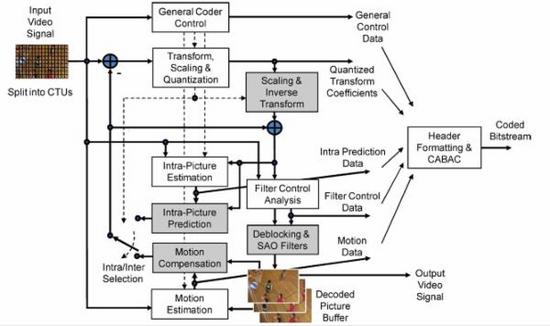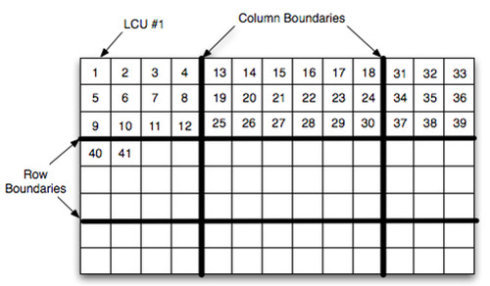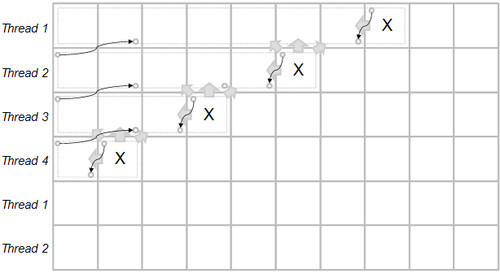概述
HEVC的设计兼顾提高编码效率、降低传输压力、增强丢包容忍性、优化并行处理在内的多个目标。
本章将简要描述HEVC实现这些目标的关键技术以及标准HEVC编码器的处理流程;解码流程和具体的语法会在之后的章节讨论。
编解码层面
HEVC的编码分层沿用了H.261以来的(混合模式帧间预测、帧内预测、2D转换)。下图表达了编码HEVC标准码流的基本过程。
- HEVC标准编码过程大致如下:帧首先被切分成多个块状区域,分别传输给解码器。图像序列的第一个画面(以及每一个可被拖放的帧)只使用帧内预测编码(只使用同一帧中其它区域进行预测,不依赖其他帧)。
- 其它帧中的块大多数使用帧间预测编码,过程包括选择预测模式、参考图像的运动数据和生成每个块的运动矢量(MV)。
- 编码器和解码器通过旁路传输预测模式信息和运动矢量(MV),计算运动补偿,进而重建帧间预测数据。
- 帧内或帧间的预测结果和实际画面之间的残差数据经过空间-线性变换、采样、量化、熵编码后和预测信息一起传输。
- 编码器会重复解码器的处理循环(上图中灰色方框的部分),以保证编解码双方对子序列作出一致的预测。但编码器量化的参数被解码器逆采样、逆转换还原后只能得到近似的残差。
- 残差和预测的结果合并后会进入一或两个循环滤波器以去处块效应。最终得出的画面(解码器的输出)会存储在缓冲区中作为视频中其它图像预测参考。
- 编解码帧序很可能会和从源下来的帧序不一样,因此对解码器来说,需要一段缓冲区来应对解码顺序(码流顺序DTS)和输出顺序(显示顺序PTS)间的差距。
- 一般而言,HEVC编码器输入都应该是逐行扫描的(逐行源,或去交错处理后的隔行源)。HEVC的编码设计没有特意去支持隔行扫描,因为隔行扫描已经不再用于最终显示,在分发中使用隔行的场景也在大量减少。
- 但HEVC提供了一个元数据让编码器可以声明这是一个按照场编码的隔行视频(每帧中其实只有一个场),每个画面中只有一半的信息。这样就简单而有效地降低了解码器支持隔行视频的复杂度。
HEVC混合编码特性中的要点
1) 编码树单元(CTU)和编码树块(CTB)
前代标准中的核心编码层是宏块,包含一个16×16的亮度块采样,对于一般的yuv420而言,会伴随两个8×8的色度块采样。类似结构在HEVC中被称作CTU,但它的大小是可以由编码器设定的,并且可以超越16×16。CTU由一个亮度CTB、几个色度CTB和一些关联的语法元素组成。亮度CTB的可选大小有16×16、32×32、64×64,更大的块会有更好的压缩率。HEVC还支持使用树结构和四叉树将CTB切分为更小的块。
2) 编码单元(CU)和编码块(CB)
CTU中的四叉树确定了亮度和色度CB的大小和位置,四叉树的根节点与CTU关联。亮度CB最大可以支持到亮度CTB的大小。把CTU切成亮度和色度CB的过程是一体的。一个亮度CB、两个色度CB和关联的语法元素构成一个CU。一个CTB可以只包含一个CU,也可以包含好几个CU,每一个CU都有一个分区关联的预测单元(PU)和一个变换树单元(TU)。
3) 预测单元(PU)和预测块(PB)
某帧图像采用帧内预测还是帧间预测是在CU层面决策的。PU分区结构的根也在CU层。根据预测决策的结果,亮度和色度CB进一步拆分为亮度和色度PB。HEVC支持从4×4到64×64大小的PB。
4) 变换单元(TU)和变换块(TB)
预测残差使用块变换编码。TU树结构的根在CU层面。亮度CB的残差可能和亮度TB完全一样,或者进一步切分为更小的亮度TB。色度TB也是一样的。4×4、8×8、16×16、32×32的TB都各自定义了近似DCT变换的基本整型方法。对于4×4的亮度帧内预测的残差变换,还有一个DCT变换表衍生的整型变换供选择。
5) 运动矢量
标准中采用了基于邻近PB和参考帧数据来预测方向的高级运动矢量预测(AMVP)。MV编码还可以使用一种允许继承邻近PB的MV的合并模式。此外,HEVC中还包含有一个增强版的H.264/AVC直接运动预测。
6) 运动补偿
MV使用四分之一采样预测。分级采样的插值使用7阶或8阶的滤波器(H.264/AVC中插值使用二分之一采样的6阶滤波器和四分之一采样的线性插值)。和H.264/AVC一样,HEVC也使用多参考帧。每一个PB可以根据单向或者双向预测传送一个或者两个运动矢量。同H.264/AVC一样,预测信号上可以附加采样和偏移以声明预测权重。
7) 帧内预测
不使用帧间预测时,就只能基于邻近的块来做空间上的帧内预测。HEVC的帧内预测支持33个方向模式(H.264/AVC中是8个)。HEVC还设计了增强的二维变换和可选的DC预测模式。需要由预先解码出的邻近PB计算得出最优的帧内预测模式。
8) 量化控制
和H.264/AVC一样,HEVC也使用URQ(一致量化还原)。由于HEVC引入了更多的变换块,所以量化参数矩阵也随之增多。
9) 熵编码
HEVC使用CABAC来做熵编码。和H.264/AVC中的CABAC相比,得益于新引入的并行处理架构,速度、压缩率和内存占用等方面均得到了大幅改善。
10) 内置环路滤波器
和H.264/AVC一样,HEVC的帧间预测循环中也内置去除块效应的滤波器。相比H.264/AVC,HEVC的设计更重视简化决策和滤波器的流程,并且为并行处理而优化。
11) 采样自适应偏移(SAO)
帧间预测循环的去块效应滤波器之后引入了一个非线性的幅值映射的流程。主要目的是通过编码器端的直方图分析产出一些参数以增强解码器端的幅值信号还原。
语法层面
H.264/AVC以来的语法基本得到了保留,HEVC在其基础上加入了不少为应用多样性及网络丢包而设计的特性。
1) 参数集结构
能被多个区块共享的解码信息包含在参数集中。这个结构负责保证把必不可少的解码信息传输到解码端。它由H.264/AVC中的图像序列参数集扩展而来,在HEVC中被称为VPS。
2) NAL语法单元
每个语法结构都会被放进一个叫做NAL(网络抽象层)中的逻辑上的数据包中。这个包的包头中有两个字节表明了它装载的是什么用途的数据(用于判断是否需要重传)。
3) 片
可以不依赖同帧中的其它数据独立进行预测、残差重建、熵编码的部分被称为“片”。片可以是一个帧也可以只是一个帧中的一部分。片的主要作用之一是在丢包时同步用。在包式传输中一个片可以包含的数据量是被严格限制的,在这个限制内调整片内包含的CTU数量可以有效地最小化包传输产生的额外开销。
4) 增强信息(SEI)和视频可用性信息(VUI)
SEI和VUI用于存储视频元数据,比如说时间戳、使用的色彩空间、3D填充的方式等等。
并行化设计和片的改良
最后要介绍的是HEVC中增强的并行处理架构和为包传输而改良的片结构。这两个特性可能会在某些应用中十分有用,具体实现可以考量自己的情况采用它们。
1) 并行块(Tile)
HEVC定义了一个可选的方式,可以把一帧图像分割成并行块。并行块的主要目的是在增强并行处理的能力同时又不引入新的错误扩散。并行块是一些在一帧图像内使用一些共有的信息编码而成,但可以独立解码的区域。一般的做法是将图像切割成包含大体相同数量CTU的并行块。并行块的引入使得简单粗粒度的并行化处理成为可能,线程之间将不再需要考虑复杂的同步和锁。
2) 错峰并行处理(WPP)
主要用于熵编码。当WPP开启时,片先被分成数个CTU行。第一行正常处理,第二行在第一行处理完2个CTU后开始处理,第三行在第二行处理完2个CTU后开始处理。每一行相对前一行都有2个CTU的延迟。WPP提供了一种在适当的层级上(比如说片)并行化的方式。WPP可以提供比并行块更好的压缩效率,而且不会引入块效应。
3) 依赖更小片(Dependent slice segments)
这个设计允许数据与错峰并行处理或者并行块关联起来,在碎片化的包传输网络中,相对于一次编码一整片而言,这种做法可以更快进入解码流程,从而降低延迟。与错峰并行处理一起使用用时,它也需要类似错峰的机制。这项设计尤为适合低延迟要求下的并行处理。

























 2577
2577

 被折叠的 条评论
为什么被折叠?
被折叠的 条评论
为什么被折叠?








